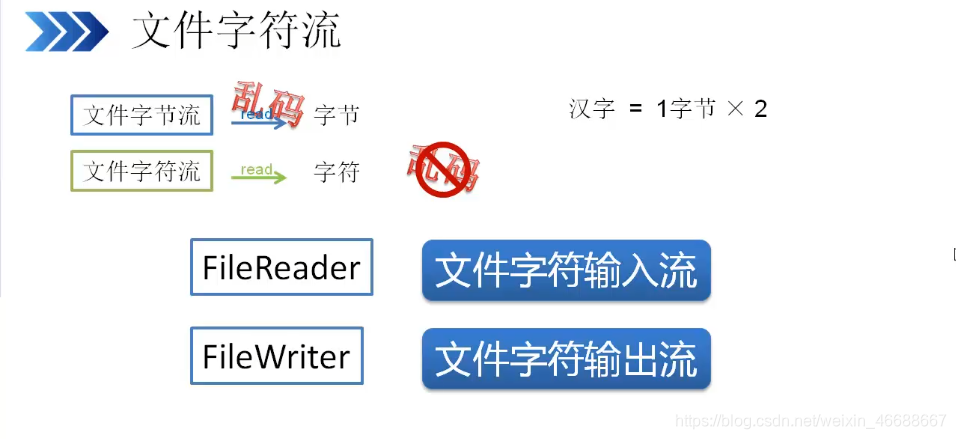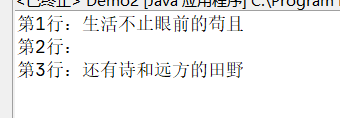文件输入/输出流
package zhao;
import java.io.*;
public class Demo {
public static void main(String[] args) {
File f = new File("word.txt");
FileOutputStream out = null;
try {
out = new FileOutputStream(f, false);// true在文件末尾追加内容,false替换文件内容
String str = "你见过洛杉矶凌晨四点的太阳吗?";
byte b[] = str.getBytes();// 字符串转换为字节数组
out.write(b);// 将字节数组中数据写入到文件中
} catch (FileNotFoundException e) {
e.printStackTrace();
} catch (IOException e) {
e.printStackTrace();
} finally {
if (out != null) {
try {
out.close();
} catch (IOException e) {
e.printStackTrace();
}
}
}
FileInputStream in = null;
try {
in = new FileInputStream(f);// 输入流读文件
byte b2[] = new byte[1024];// 缓冲区
int len = in.read(b2);// 读入缓冲区的总字节数
System.out.println("文件中的数据是:" + new String(b2, 0, len));// 去掉空格
} catch (FileNotFoundException e) {
e.printStackTrace();
} catch (IOException e) {
e.printStackTrace();
} finally {
if (in != null) {
try {
in.close();
} catch (IOException e) {
e.printStackTrace();
}
}
}
}
}

文件字符流

package zhao;
import java.io.*;
public class Demo {
public static void main(String[] args) {
File f = new File("word.txt");
FileWriter fw = null;
try {
fw = new FileWriter(f, false);// true在原文件后追加,false覆盖
String str = "自强不息,厚德载物。";
fw.write(str);// 将字符串写入到文本文档
} catch (IOException e) {
e.printStackTrace();
} finally {
if (fw != null) {
try {
fw.close();
} catch (IOException e) {
e.printStackTrace();
}
}
}
FileReader fr = null;
try {
fr = new FileReader(f);
char ch[] = new char[1024];// 缓冲区
int count;// 已读出的字符数
while ((count = fr.read(ch)) != -1) {
// 循环读取文件中的数据,直到所有字符都读完
System.out.println("文件中的内容为:" + new String(ch, 0, count));
}
} catch (FileNotFoundException e) {
e.printStackTrace();
} catch (IOException e) {
e.printStackTrace();
} finally {
if (fr != null) {
try {
fr.close();
} catch (IOException e) {
e.printStackTrace();
}
}
}
}
}

缓冲字节流

没有缓冲字节流
package zhao;
import java.io.*;
public class Demo {
public static void main(String[] args) {
File f = new File("C:\\Users\\zhao\\Desktop\\0GLCFCS30产品说明.docx");
FileInputStream in = null;
long start = System.currentTimeMillis();// 获取流开始时毫秒值
try {
in = new FileInputStream(f);
byte b[] = new byte[1024];// 缓冲区字节数组(这个缓冲区与Buffered不同)
while (in.read() != -1) {
}
long end = System.currentTimeMillis();// 获取流结束时毫秒值
System.out.println("运行经历的毫秒数:" + (end - start));
} catch (FileNotFoundException e) {
e.printStackTrace();
} catch (IOException e) {
e.printStackTrace();
} finally {
if (in != null) {
try {
in.close();
} catch (IOException e) {
e.printStackTrace();
}
}
}
}
}
运行经历的毫秒数:4535
添加缓冲字节流
package zhao;
import java.io.*;
public class Demo {
public static void main(String[] args) {
File f = new File("C:\\Users\\zhao\\Desktop\\0GLCFCS30产品说明.docx");
BufferedInputStream bi=null;//大大提高运行效率
FileInputStream in = null;
long start = System.currentTimeMillis();// 获取流开始时毫秒值
try {
in = new FileInputStream(f);
bi=new BufferedInputStream(in);//将文件字节流包装成缓冲字节流
byte b[] = new byte[1024];// 缓冲区字节数组(这个缓冲区与Buffered不同)
while (bi.read(b) != -1) {
//使用缓冲流读取数据
}
long end = System.currentTimeMillis();// 获取流结束时毫秒值
System.out.println("运行经历的毫秒数:" + (end - start));
} catch (FileNotFoundException e) {
e.printStackTrace();
} catch (IOException e) {
e.printStackTrace();
} finally {
if (in != null) {
try {
in.close();
} catch (IOException e) {
e.printStackTrace();
}
}
if (bi!=null) {
try {
bi.close();
} catch (IOException e) {
e.printStackTrace();
}
}
}
}
}
运行经历的毫秒数:2
上面是缓冲输入字节流,下面是缓冲输出字节流
package zhao;
import java.io.BufferedOutputStream;
import java.io.File;
import java.io.FileNotFoundException;
import java.io.FileOutputStream;
import java.io.IOException;
public class Demo2 {
public static void main(String[] args) {
File f = new File("word.txt");
FileOutputStream out = null;
BufferedOutputStream bo = null;
try {
out = new FileOutputStream(f);
bo = new BufferedOutputStream(out);// 将文件输出流包装
String str = "仰天大笑出门去,我辈岂是蓬蒿人。";
byte b[] = str.getBytes();
bo.write(b);
// 使用缓冲字节输出流时,要多进行刷新操作,避免等待
bo.flush();// 刷新、强制将缓冲区数据写入文件中,即使缓冲区没有写满
} catch (FileNotFoundException e) {
e.printStackTrace();
} catch (IOException e) {
e.printStackTrace();
} finally {
if (out != null) {
try {
out.close();
} catch (IOException e) {
e.printStackTrace();
}
}
if (bo != null) {
try {
bo.close();
} catch (IOException e) {
e.printStackTrace();
}
}
}
}
}
缓冲字符流

缓冲字符输出流
package zhao;
import java.io.*;
public class Demo {
public static void main(String[] args) {
File f = new File("word.txt");
FileWriter fw = null;
BufferedWriter bw = null;
try {
fw = new FileWriter(f);
bw = new BufferedWriter(fw);
String str1 = "生活不止眼前的苟且";
String str2 = "还有诗和远方的田野";
bw.write(str1);
bw.newLine();// 创建一个新行
bw.write(str2);
} catch (IOException e) {
e.printStackTrace();
} finally {
// 要注意流的关闭顺序,先创建的后关闭
if (bw != null) {
try {
bw.close();
} catch (IOException e) {
e.printStackTrace();
}
}
if (fw != null) {
try {
fw.close();
} catch (IOException e) {
e.printStackTrace();
}
}
}
}
}

缓冲字符输入流
package zhao;
import java.io.*;
public class Demo2 {
public static void main(String[] args) {
File f = new File("word.txt");
FileReader fr = null;
BufferedReader br = null;
try {
fr = new FileReader(f);
br = new BufferedReader(fr);
String tmp = null;
int i = 1;
while ((tmp = br.readLine()) != null) {
// 循环读取文件中的内容
System.out.println("第" + i + "行:" + tmp);
i++;
}
} catch (FileNotFoundException e) {
e.printStackTrace();
} catch (IOException e) {
e.printStackTrace();
} finally {
if (br != null) {
try {
br.close();
} catch (IOException e) {
e.printStackTrace();
}
}
if (fr != null) {
try {
fr.close();
} catch (IOException e) {
e.printStackTrace();
}
}
}
}
}
